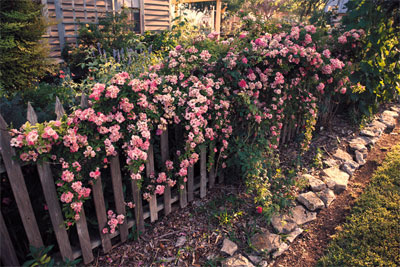Rose Cuttings – January, 2011

‘Peggy Martin’, trained on a fence at the Antique Rose Emporium. Photos courtesy of Mike Shoup.
Vertical Bones
Climbing Roses — as good as the structures that support them and the gardener who trains them

‘Climbing Old Blush’, artfully trained on a arch.
Climbing roses grow! In fact, they are so vigorous that far too many people who plant them end up digging them up because they underestimated their potential. Canes engulfing adjacent plantings, covering up walkways or smothering the small trellis that was placed there for support are common outcomes for gardeners who do not plan properly. A climbing rose’s success doesn’t reside in its ability to grow, but in the ability of the gardener to properly select a structure that can support it and to properly train it on that given structure.
Familiarize yourself with the phrase, “You must harness the rose, not let the rose harness you!” Remember, every cane from a climbing rose must have a purpose. The canes must be tightly affixed to the structure they adorn. Those canes that cannot be attached should be removed (as much as one half of a climber can be removed in early spring.) The resulting structure, pillar, trellis, arbor, pergola or fence will look clothed in canes in the shape of the structure, embellishing it as was your initial intent. Gone are the canes that reach out and grab you as you pass by. Gone is the disarray of untrained branches. Come springtime, the dramatic result of this training effort might be a knock on your door from Neil Sperry, asking to photograph your yard for the cover of his magazine!
About the author: Mike Shoup is the owner of the Antique Rose Emporium. Visit his company’s Brenham and San Antonio display gardens for endless ideas on landscaping with roses. To order roses online, visit www.weAREroses.com.

